Hello BSA enthusiast,
Because mine headgasket was swetting oil, i wanted to fix this and took of the cilinder head. What I see then I didn’t expect. The cylinder has a dent on 2 oppesit side of the cylinder. One is havy damaged en the other dent is not that deep. I than took the cylinder of en saw the piston was melted on the hole where the pistonpen goes in. The clips where also damaged. I want to know what happened here, becausde this engine only drove 400 miles. I did 3 oil changes in that 400 mile and drove it normally. Beforte I am going to take this to revision again, I need to know what happened. Has anyone ever seen this before?? Take a look at the pictures
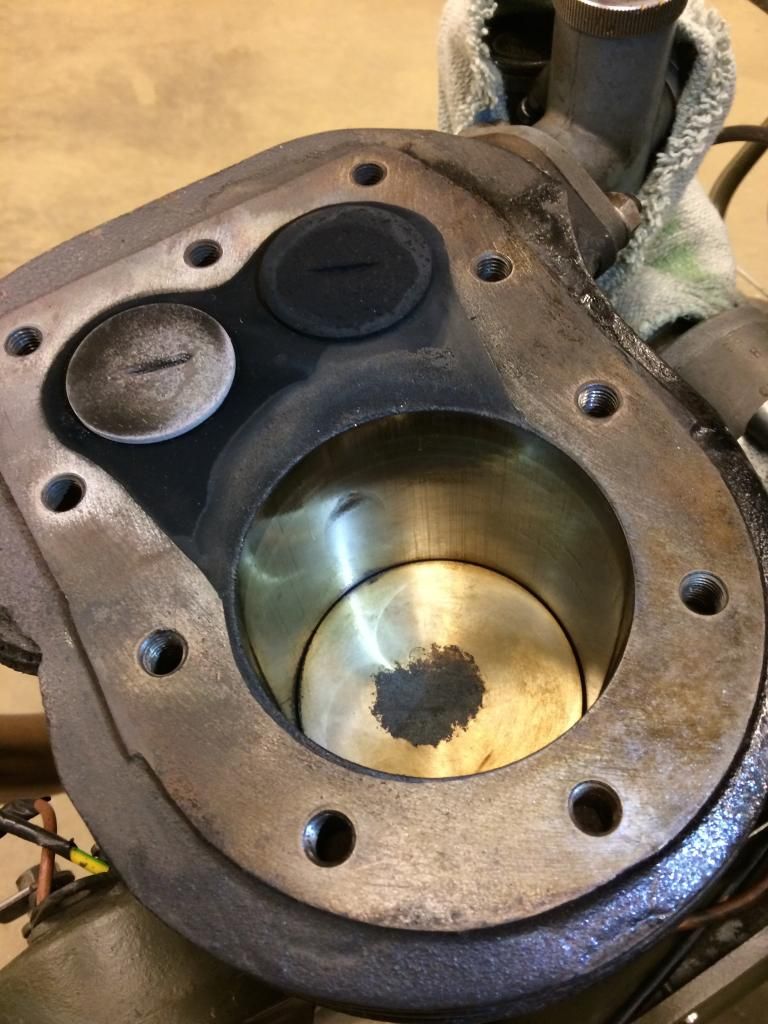
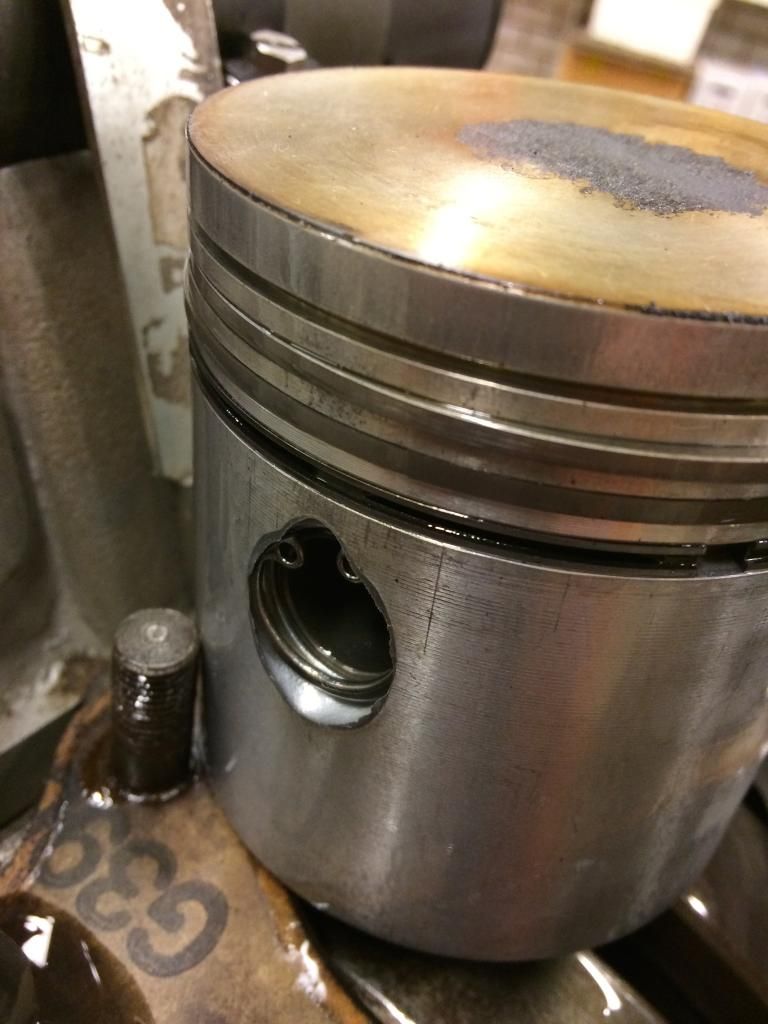
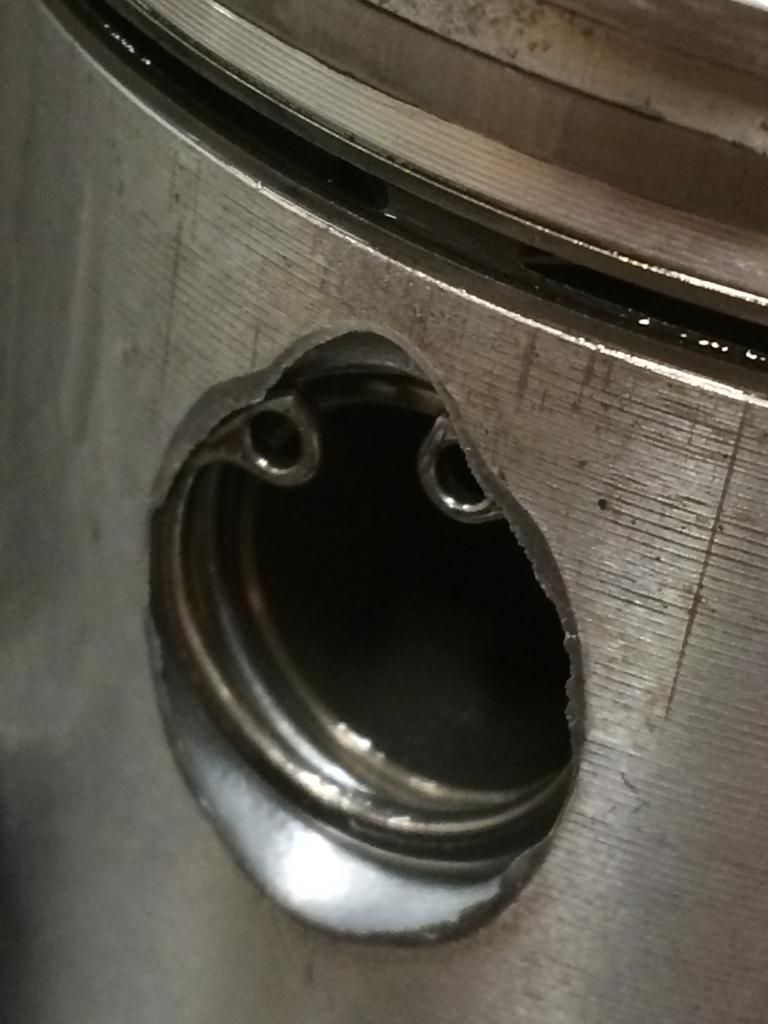
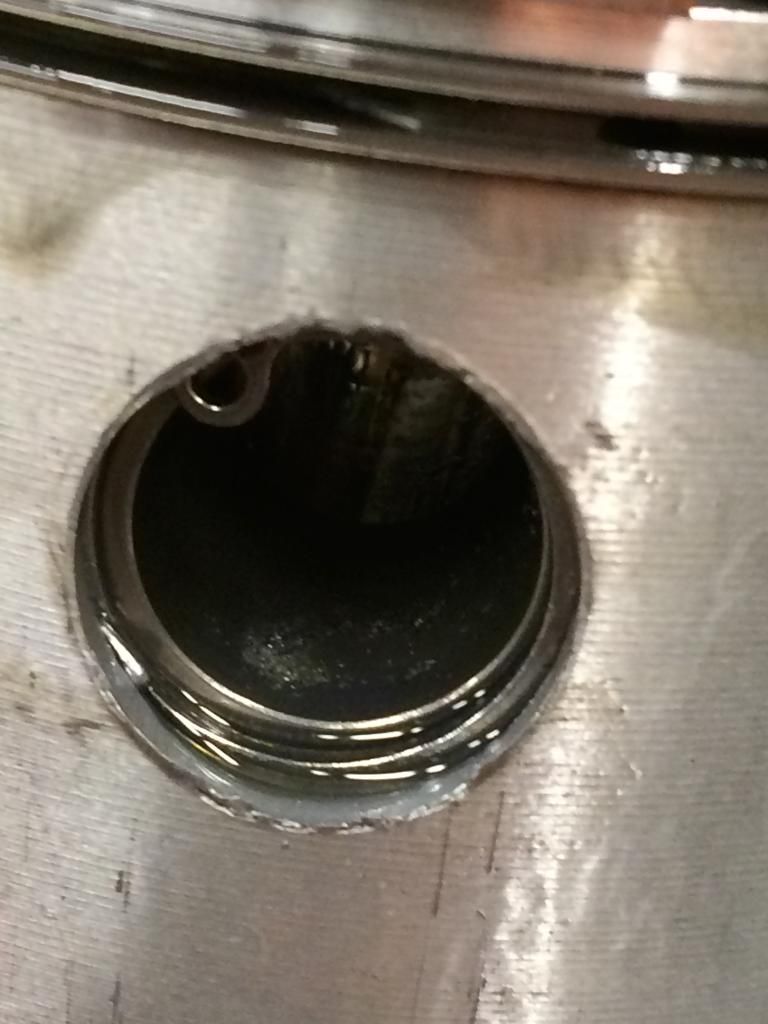
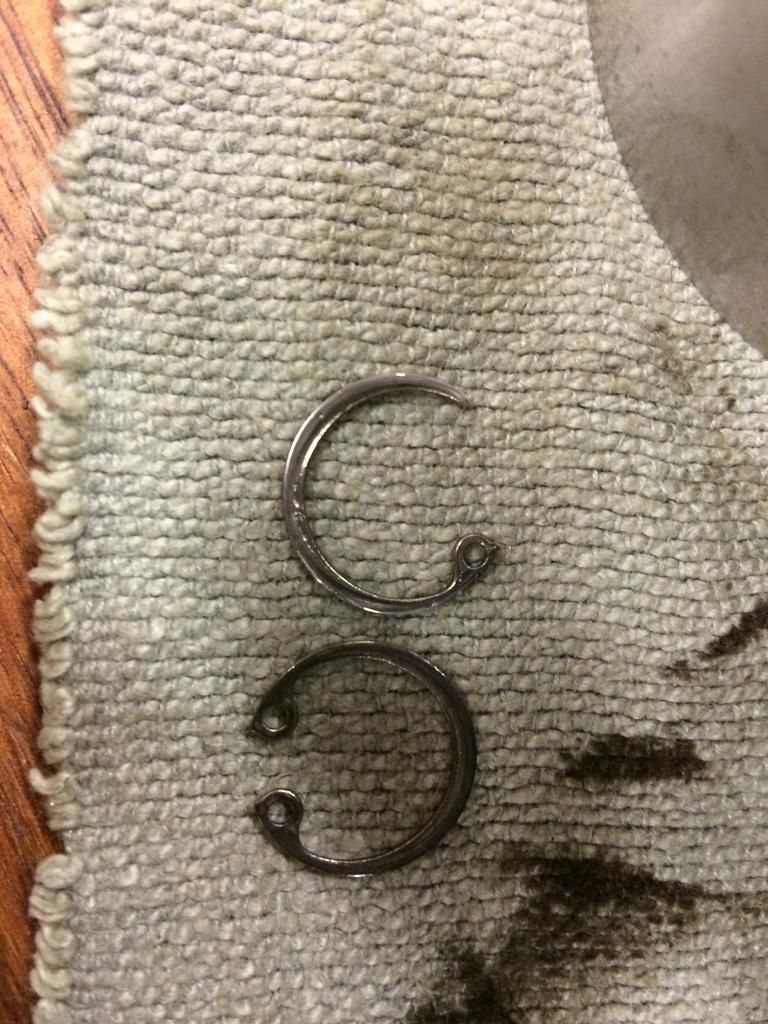
email (option): j.roos@outlook.com
Jeroen, could the circlip not have been in it's groove? This would allow the wristpin to travel and score the side of the cylinder. I'm curious as to why it would only do it at TDC though and not show a score all the way up and down. Plus you say it happened on the other side too? The circlip seems fine there. Interesting also how that score shows the shape of the circlip in the cylinder wall and the piston seems fine other than where the wristpin is. There enough of me stating the obvious! :-) The experts here will sort this out for you!
Most probably a well known fact by you folks on here , but for those that don't know , these circlips like to be fitted one way only , thats with the sharp outer edges facing outwards,not the with the slightly rounded edges outwards .
Not saying this was the cause , just a bit of hopefully usefull info .
To me it looks like the engine has been running retarded and got too hot. The piston has melted in this area and as the bike has stopped the heat has transferred to the bore. That's my guess. The exhaust valve has definitely got very hot to be white like that and all the carbon has burnt off the piston crown. It can't be the mixture running too lean as there is plenty of soot around the inlet valve area. What's the sparkplug like? I would double check your timing and make sure you've been running the bike with the advance/retard lever the right way.
email (option): horror@blueyonder.co.uk
Perhaps it's meant to have the round profile circlips?
That was my first thought...Was this a new after market piston?...Ian
email (option): ian@wright52.plus.com
Hi,
one off the circlips had an eye broken off.
Did you find it ?
When it did, it couldn't escape, so probably damaged the cilinder liner.
Indeed strange that it only happened in two places (??)
If you look at the shape of the damage on the barrel it's the same shape as the damage on the piston.I would say the circlip has melted.
email (option): horror@blueyonder.co.uk
I reckon the circlip popped out and got carried up and down in the chamfer, and somehow avoided getting smeared right up the bore. I don't quite understand how it got back in the gudgeon pin bore though ?
The fact that it has contacted the bore just short of TDC makes me wonder if there is a conrod straightness / alignment problem which might even have contributed to a lateral force on the pin....possibly. I'd certainly check it.
I was wondering about this too, perhaps a misaligned flywheel to cylinder problem? Bent conrod? Almost as if the piston got up to TDC and did the hokey pokey, shook it all about and then went back down. I'd be curious to see if the same scores are on the cylinder at BDC where the piston reverses it's direction.?
I would check also for other causes for the heating:
1. was the gasket under the barrel was properly positioned,
And not 180 deg' around, blocking holes in the bottom case?
2. Did the piston gudgeon pin had enough free movement at the conrod bushing?
If not, it would rotate in the piston when the engine is working,
Rather than in the conrod bushing, transferring a lot of heat there..
Good luck, 
Noam.
email (option): noam10@gmail.com
If the circlip had popped out and worm away against the bore there would be a groove up and down the bore. The circlip would have probably gone between the piston and bore, but even if it didn't, it wouldn't pop back in it's groove again. The circlip hasn't come out. Whatever has caused the damage on the bore, it has happened when the piston is not moving for it to be the same shape as the damage in the gudgeon pin hole. The damege on the piston also hasn't happened from wear on the bore as nothing can touch the inside of the hole to make it disappear.
We've been assuming the damage has happened while riding along. The only time I've seen damage on a bore that corresponds to the piston is when water or condensation has got in the bore and rust has formed. If the bike's been stood for some time, water could have settled in the gudeon pin holes and rusted the same shape on the bore. It would also corrode the piston around the hole. The bike has been recomissioned and run again which has cleaned off the rust just leaving the pitting and one end of the circlip rusted away.
email (option): horror@blueyonder.co.uk
I think more information about the piston, clips and history of the engine is required before formulating a theory...
Also more photos of the bore and piston condition....
It appears to be a new piston but were the clips the ones supplied with the piston, was the cylinder rebored etc. etc?...
I don't think the clip has melted...The piston would have seized before that happened and there doesn't appear to be any discolouration of the clip or gudgeon pin....Ian

email (option): ian@wright52.plus.com
I would agree with Mr H. Looks like corrosion in the bore indentation rather than a fresh gouge, so would indicate long term corrosion with the piston stuck in the bore, prior to recommissioning.
I don't think those circlips are anywhere near the correct ones for the piston. They both seem to have come out of their groove, got damaged by the bore and somehow half got back in the groove.
More photos might show that the piston is designed for WIRE type circlips.
I cannot see any indications of overheating by the way.
Thanks everyone for the response!
The cilinder was rebored and honed 400 miles ago to m20+ 60.
The piston comes from the company i put a link below. I think they are after market piston. The clips i ordered with the pistonrings from an other company in holland " de Groot" .
I dindn't found the eye of the clip.
The gasket below the cilinder was not blocking hole's and the giddier pin had enough movement at the corned bushing.
The damage on TDC is also on BDC
I did not take a picture of the spark plug, but tomorrow i wil go to my motor again and wil take a picture.
http://www.vintage-motorcycle.com/index.php?language=en&site=4&pid=160&limit=60
Greetings Jeroen
email (option): j.roos@outlook.com
Where did the circlip ear go ? Could that have been floating about inside the pin ? Something as small as that could mill the edge of the piston. I agree with Keith though. There is something wrong with those circlips. They shouldn't have been able to move.
We've all seen pictures of clips that have gone right down the bore but this engine has done little mileage...maybe it was dismantled before the clips went all the way.
Whatever, it needs a rebore, decent piston with matching circlips, con-rod check, valve check and re-time.
It doesn't seem to be a common problem so there is hope that it won't happen again. The joys of classic motorcycling and parts of obscure origin...Please name the make and source of the piston / circlips.
I think the route cause of the problem is the circlips...
Clips of this type have a square edge and are not suitable for fitment to a piston that is machined to take wire clips, particularly clips that use the small diameter wire as fitted to BSA pistons...
I don't think there is much to indicate an overheating problem caused by weakness of the mixture or incorrect timing...The carbon deposits around the valves indicate a rich rather than weak mixture,
There is also no discolouration of the steel components and more tellingly, no scuffing or other damage on the piston skirt or thrust faces....
When an engine overheats to a critical degree virtually without exception the first thing to fail is the piston...
The pale discolouration on the exhaust valve is not unusual either...It should be noted the exhaust valve is running at close to 'red hot' in a side valve under normal operating conditions...
The damage on the piston is limited to the area around the gudgeon pin bore and IMO the most likely explanation is it results from the effects of a dislodged circlip (or clips)...Ian
email (option): ian@wright52.plus.com
I agree that the circlips don't seem right. I have had a bit of experience with a twisted rod before, examining the piston as it travels up and down the bore I have found that it seems to travel reasonably true, but when it gets to TDC and BDC it will give a kink as the twisted rod must reverse it's direction. The piston seems to bounce off both sides of the bore. With incorrect circlips, the sideways action put on the wrist pin by a bent rod trying to turn directions might pop the circlips out, causing to wrist pin and circlip to flail the sides of the bore as the piston reaches TDC and BDC. If you look at the damage, you can clearly see the shape of the circlip embedded into the cylinder wall, this would seem to indicate a constant hammering. The fact that you say the same damage is present at BDC with no damage in between seems to indicate something is happening when the piston is reversing directions. Again, this is pure speculation from no more than a backyard mechanic, but I would certainly check the trueness of the rod including making sure the small end bush hasn't been installed and honed out of true, that's just as bad as having the rod bent if it's out enough.
Sorry to keep rambling here, but just a final note. With my cylinder head off and a twisted rod, as I mentioned you see the piston bounce off the sides of the bore at TDC and BDC. Removing the cylinder, I took out the circlips and reassembled the lot, I then found that looking down the bore I could notice that the piston had stabilized some when rounding top and bottom, but the wrist pin was now moving back and forth to a point where if the engine was given a fast enough turn there would be an audible ping when the wrist pin would hit the cylinder wall at TDC and BDC.
Clips of this type have a square edge and are not suitable for fitment to a piston that is machined to take wire clips, particularly clips that use the small diameter wire as fitted to BSA pistons...
I don't think there is much to indicate an overheating problem caused by weakness of the mixture or incorrect timing...The carbon deposits around the valves indicate a rich rather than weak mixture,
There is also no discolouration of the steel components and more tellingly, no scuffing or other damage on the piston skirt or thrust faces....
When an engine overheats to a critical degree virtually without exception the first thing to fail is the piston...
The pale discolouration on the exhaust valve is not unusual either...It should be noted the exhaust valve is running at close to 'red hot' in a side valve under normal operating conditions...
The damage on the piston is limited to the area around the gudgeon pin bore and IMO the most likely explanation is it results from the effects of a dislodged circlip (or clips)...Ian

The mixture was indeed rich! I didn't want it to become hot, thats why i set the mixture rich. The engine run very good and if you want, i can post a film of it. I also think something went wrong with the clips.
email (option): j.roos@outlook.com
I think Sam has made a good point...It's well worth checking the conrod is straight...
The long M20 conrod is easily bent if too much force is used when removing/refitting a small end bush, removing the gudgeon pin without first heating the piston or when the cylinder and head are left off a bottom end that is not in the frame....
With the pin in the rod it is simply a case of rigging up some parallel bars on the crankcase mouth and checking for 'line contact' of the pin across the bars on both sides of the small end....
Saying that though, the piston skirts and ring lands show little sign of contact with the bore...There is usually some marking of the skirt when the piston is 'tilted' out of square to a vertical bore...Ian
email (option): ian@wright52.plus.com
All I can say is this exactly what happened to my Matchless G80 this summer, however mine carried on a lot longer than yours, all summer and a couple of rallies of 600+ miles with only a increasing rattle and oil consumption! That's AMC for you. When I took the engine apart the gudgeon pin was fine the piston size was fine but the eye of the Seager circlip was missing and had erroded the piston away, pinning the oil ring in it's groove and allowing the pin to contact the bore a scoring a lovely groove in it to way beyond +60 size. my diagnosise is the circlip was fatigued and in a groove it did not completely match. Refering to "Tuning for speed" The general jist is that circlips are a fruitfull source of engine failure and only new circlips should be used in the appropriated type of of groove, square for Seager, half round for wire. If Seager the pin shoud be perfectly sqare on the end and with a small amount of end float, for wire the pin can be slightly chamfered to encourage the circlip in it's groove but in both types the fit should be "perfect". Any Seager circlip that shows signs of being pressed out with a crisp and a rounded side needs to be rejected for one ground on both sides to true size. Any overheating is proberly a result of increasing inefficiency
Richard
email (option): Circlips
Forgot mention,check the pin is level relative to the crancase mouth, a decent vernier is OK for this with the rod at TDC, although I've never had an engine that wasn't "square" so far.
Richard
email (option): Circlips
As a matter of interest the wire pattern circlip for the M20 is the same dimensionally as that for a Triumph T140...and those are readily available...Ian
email (option): ian@wright52.plus.com
The long M20 conrod is easily bent if too much force is used when removing/refitting a small end bush, removing the gudgeon pin without first heating the piston or when the cylinder and head are left off a bottom end that is not in the frame....
With the pin in the rod it is simply a case of rigging up some parallel bars on the crankcase mouth and checking for 'line contact' of the pin across the bars on both sides of the small end....
Saying that though, the piston skirts and ring lands show little sign of contact with the bore...There is usually some marking of the skirt when the piston is 'tilted' out of square to a vertical bore...Ian

Damage at TDC & BDC only fits in perfectly with a twisted rod or crankshaft out of alignment.
As the piston gets to TDC th rod "pushes" the pin sideways into the bore, when it gets to BDC it pulls the pin into the bore.
The verification of this happening is the damage being more pronounced on one side at the top and the opposite side at the bottom. the damage at both ends of the stroke should be slightly higher on one side of the bore at both TDC & BDC.
the broken lump out of the piston side is consistant with the pin being hammered into the circlip at each end of the stroke.
A picky of the underside of the piston will confirm or dispell the overheating.
A gudgeon pin hole machined slightly off square will also produce the same effect.
Some more photos showing the entire piston top to bottom might help.
A twisted or bent rod will produce distinctive wear patterns but we need to see the piston from 4 sides top to bottom
email (option): wariron@tpg,com,au
impressive!
Adding nothing but agreeing that it has to be something causing the wrist pin to load up the circlip and basically punching the piston aluminium out of the side of the piston.
Were the debris is, almost certainly in the crankcase somewhere - always a good idea to place some cloth or something into he crankcase mouth as soon as you can see daylight between cylinder and case - not easy I know when holding a side-valve cylinder in one hand.
Around mid stroke (depending on rod/stroke ratio)is the point of max cylinder/piston load - hence the localise wear, approximating in shape to the wrist pin.
I've seen a ducati 900ss run for many hundred miles with no piston circlips in, at all - so there should be very little load on the these items.
Again as everyone else says - con-rod bent, or something else causing this side load - broken crankpin allowing main-bearing deflection under load ?
Still very Impressive!
email (option): GINANTONIK@TISCALI.CO.UK
i-am sorry guys, but with sport this weekend i got injured. I can't walk at the moment, so fixing the bike is not possible. I know from all of you that the clips are not correct. I also think that is not the only problem. When i am able to walk i will check the crankshaft and rod if they are straight and in line. If they aren't, it will explain a lot. I will keep you informed
. Thanks for all your comments and help!
email (option): j.roos@outlook.com
Trevor, I agree, damage at top and bottom only are symptoms of a twisted rod, not a bent rod. As I stated, I noticed that with a twisted rod, the piston kinks in the bore only at TDC and BDC. When it travels between the two it is quite stable and centered. With the circlips removed the pin would strike one side of the bore at the top and the other at the bottom. This is with a hand swing of the flywheel. This does not explain however why the damage from hammering would happen on both sides top and bottom, but with both circlips gone, a twisted rod and the engine running, who knows what the pin does, could very well hammer both sides. As you say, more photos are needed. Get well soon Jeroen!
I've got a Matchless G3 pot in my spares collection with exactly the same damage in it. I've no idea why or when this happened, but you're not alone. 
I have never seen anything like it before. I've seen bent con rods and the result is a badly scuffed piston and bore on one side.
I'm still puzzling how this damage can happen. If the con rod was twisted slightly in it's length I can't see it throwing the gugeon pin backwards and forwards so hard that is marks the bore. The piston would still be travelling virtically so I can't see where the force is coming from to move the pin. The only thing I can think of is an out of line crank pin. This would make the con rod twist one way then the other, which if the gugeon pin was very loose may make it move. We need to know if the damage on the bore at the top and bottom is off of 90 degrees to the con rod. If it's at 90 degrees I can't see why the pin would move.
email (option): horror@blueyonder.co.uk
Thinking about it again, the point where the piston is at the top and bottom of the stroke, the gugeon pin would be at 90 degrees to the con rod but tilted upwards and downwards, so the momentum of the piston travel would be in the right direction to move the pin. Looking at the picture, the damage does look like it's in line with the bolt holes left and right of the bore.
email (option): horror@blueyonder.co.uk
